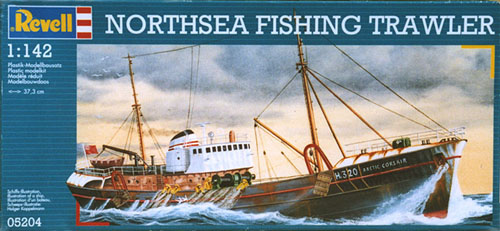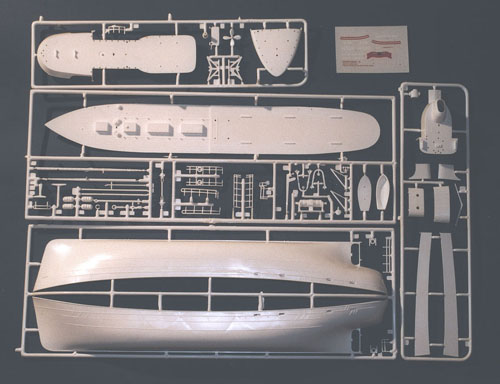
Kit review: Northsea Fishing Trawler, Revell, 1/142 scale, kit #05204
By Christian Schonberger

Model length: 37,3 cm = 14, 11/16th in.
Since I live in coastal Portugal, I often see fishing boat models, mainly in souvenir shops and seafood restaurants. So I couldn’t resist buying this kit when I saw it at the local hobby shop.
The nicely done boxtop artwork depicts a well weathered British fishing trawler named Arctic Corsair. The decal sheet contains this name for the sides of the bow and the stern together with numbers/letters, red funnel stripes, British flag (unfortunately with some two-dimensional "waves" but not as bad as those from the 1950s and 60s kits) plus draught marks.
I remember vaguely a Russian Spy Trawler by Revell from long ago, but I don’t think this kit came from the same molds as the one reviewed here – at least I was unable to find any "spying equipment" left nor was I able to spot any traces of a modification. I could be mistaken though.
The parts come in four frames, all white in a strong styrene of high quality. All parts come in one unsealed clear bag closed by adhesive tape. Only the lifeboat hull came loose. The German/English instructions and the decal sheet, both printed in Germany, indicate: © 1998, but engraved into two decks we can read: © 1993 Revell Monogram USA. This could be the date of the original molding, but I have some doubts. This might very well be an older kit, the molds possibly bought by Revell. I wouldn’t be surprised to find the same moldings having been sold under a different ship’s name in the past. In any event the oddball scale of 1/142 (why not one the established scales 1/144 or 1/100?) is typical Revell.

The kit parts are very cleanly molded with few flash only. The mold design looks very old fashioned and hand-tooled (pre CAD) – hence the reason I suspect that this is a much older kit than indicated. I was unable to spot any sink marks. Surfaces are very smooth without scratches except for a couple on the planked main deck which can easily be neglected.
Many a detail is presented by raised lines including doors, unfortunately also the bridge windows, portholes, vertical ladders and the main deck planking including exaggerated wood grain. The railings are only slightly oversized in cross section and with a little cleaning/ thinning-out with a hobby knife and sand paper they should look just fine without the need for photoetched brass or similar fittings. The only downside is that the life rings are molded into the railings. I recommend fabricating these from scratch or from scrap pieces for later addition after painting to obtain a more convincing result.
Something I find annoying is the bad alignment of the scuppers meant to drain the main deck from sea water, located at the aft part of the hull. These are too low and almost completely closed from the inside parts of the moldings – they don’t make any sense as represented in the kit. A possible fix is to sand down the outer raised hull line at main deck level and replace it by small styrene square rod (for example Evergreen 0.75mm x 0.75mm) wrapping the entire hull and nearly closing the scuppers, leaving only a thin part above main deck level. Now the scuppers can be moved further upward by filing and sanding. A styrene strip has the added advantage that it will closer resemble the nice boxtop artwork and that it can be painted in a different color easily, for example red as shown on the boxtop but not in the instructions. I think this fix is not too hard and definitely worth the effort.
There is no support included for static display but the very small propeller shaft with no protruding housing indicates that this model was never intended for housing a motor and/or R/C gear either – even though a conversion is possible. So it is a static display model without a support, confirming with the b/w photo in the instructions - personally I am not too fond of the idea, but then again most supports supplied with the classic merchant ship styrene kits are less than brilliant anyway and a scratchbuilt one looks better.
The whole kit somehow has a slight "flavor" of folk art to it but that gives it its own special flair. I personally like it (maybe because it reminds me of restaurants with fresh fish and seafood).
The kit most likely has been designed with the young and/or inexperienced modeler in mind. Skill level is indicated as 3. It counts 61 parts including two figures.
The boxtop painting shows nifty worn and wavy sheet metal in some places such as the bridge front and upper bow, which would look wonderful if featured on the kit itself but unfortunately all parts are molded as smooth as glass. There is also the obligatory molded-in piece of deck rope which is a headache for the more demanding modeler who wishes to remove it and, if desired, replace it by a piece of real rope/thread. The same goes for the winch which has the ropes already molded-in.
On the high side: some parts include molded-in structural supports (steel triangles/ribs) such as the deck supporting the bridge and the inside of the hull halves above main deck. Masts, booms and cranes are finely molded. I also like the molding of the lifeboat hull. It contains clinker-built (lapstrake) planking detail (visible steps) and a canvas.
Many things indicate that this kit is not trying to represent one single Northsea fishing trawler in particular but it is rather meant as a "generic" model of an older vessel. The web site of Revell Germany states that the original dates from 1960, the kit instructions only mention that this is an older type.
The fact that the kit does not represent one particular vessel, but rather a "class" or "type" of vessel, has the advantage of giving us the freedom to add/delete/replace/change detail as we please. Nobody will judge our work with a raised index finger. Since the kit is relatively easy to build, it can make for a nice practice model to try out weathering techniques.
I paid 16 Euros for the kit which I still find reasonable.
This is an ideal kit to build just for fun. Not to be taken seriously as anything historically accurate. A few things can be done with relatively little effort to make it a better model such as cutting out windows and drilling out portholes – which are rather very few - plus the aforementioned scuppers fix.
Highs:
Easy construction/fun to build
High quality styrene plastic
Clean molds
Reasonably priced
Lows:
Molding a bit crude, not up to the boxtop artwork
Doors, portholes and ladders are just represented as raised lines
No clear parts included (since windows are not molded open)
No support included
Rating: 5.5 out of 10